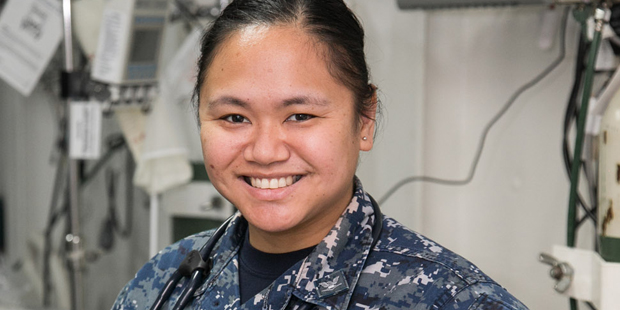
Petty Officer 3rd Class Maria Bailey is a hospital corpsman aboard the San Diego-based ship.
By MC1 James Green
A 2004 Kinnick High School graduate and San Diego, California native is serving on one of the world’s largest warships, the U.S. Navy aircraft carrier USS Ronald Reagan.
Petty Officer 3rd Class Maria Bailey is a hospital corpsman aboard the San Diego-based ship, a Nimitz-class nuclear-powered aircraft carrier and one of only ten operational aircraft carriers in the Navy today.
“My job is to assist the doctors with operations, and take care of the patients after the operations,” said Bailey
Named in honor of former President Ronald Reagan, the carrier is longer than 3 football fields, at nearly 1,100 feet long. The ship is 252 feet wide and weighs more than 100,000 tons. Two nuclear reactors can push the ship through the water at nearly 35 mph.
As a sailor with numerous responsibilities, Bailey said she is proud to serve her country aboard an aircraft carrier.
“I love that this ship has given me the opportunity to practice and apply my skills,” said Bailey.
Bailey also said she is very proud of the work she is doing as part of USS Ronald Reagan’s nearly 3,000-member crew, helping protect America on the world’s oceans.
Sailors’ jobs are highly varied aboard USS Ronald Reagan. Nearly 3,000 men and women make up the ship’s company, which keeps all parts of the aircraft carrier running smoothly — this includes everything from washing dishes and preparing meals to handling weaponry and maintaining the nuclear reactors. Another 2,000 or so form the air wing, the people who actually fly and maintain the aircraft.
“I never cease to be impressed with the type and quality of work that goes on aboard the carrier each day,” said Capt. Christopher E. Bolt, the carrier’s commanding officer. “Our team is filled with highly qualified young adults – in many cases, 19 and 20 years old – and they’re out here launching and recovering aircraft, running a complex propulsion system safely, serving as air traffic controllers, operating sophisticated electronics, and keeping this floating city alive and functioning. Their work ethic, enthusiasm, and esprit de corps are second to none. If you pick up a newspaper in any city and examine what other 19- and 20-year-olds are doing, there is no comparison to the level of responsibility our Sailors hold. That caliber of Sailor is what has earned us the title of America’s Flagship.”
USS Ronald Reagan is also a self-sustaining, mobile airport and, like each of the Navy’s aircraft carriers, is designed for a 50-year service life. While underway, the ship carries more than 70 jets, helicopters and other aircraft, all of which take off from and land on the carrier’s 4.5-acre flight deck. Four powerful catapults launch aircraft off the bow of the ship. After lowering a tail hook that protrudes from the rear of the aircraft, jets and aircraft land by snagging a steel cable called an arresting wire.
After an extended maintenance period spent pier side in San Diego, USS Ronald Reagan is preparing for its move to Japan, as part of the first ever three-hull aircraft carrier crew and hull swap. It will replace USS George Washington in Japan and become part of the U.S. 7th Fleet forward-deployed naval forces (FDNF) in Yokosuka, Japan. As part of this rebalance strategy to increase the Navy’s presence in the Pacific Fleet, USS Theodore Roosevelt will move from Norfolk, Va., to San Diego.
In 2008, George Washington was the first nuclear-powered aircraft carrier sent to Japan as part of the FDNF. Maintaining a FDNF capability supports the United States’ commitment to the defense of Japan and the security and stability of the vital Indo-Asia-Pacific region.
As a member of one of the U.S. Navy’s most relied upon assets, Bailey and other USS Ronald Reagan sailors know they are part of an agile and skilled team standing ready to defend America.
The Navy is uniquely positioned to be there, on the world’s oceans, patrolling what is essentially the world’s interstate ocean highway system. The U.S. Navy ensures the free flow of global trade which, in turn, preserves America’s economic prosperity. When it comes to protecting and defending America, being there matters. And America’s Navy is already there.
“I enjoy traveling and the Navy has provided me with the opportunity to do that all expenses paid,” said Bailey.
“Why Being There Matters”
On our planet, more than 70 percent of which is covered by water, being there means having the ability to act from the sea. The Navy is uniquely positioned to be there; the world’s oceans give the Navy the power to protect America’s interests anywhere, and at any time. Your Navy protects and defends America on the world’s oceans. Navy ships, submarines, aircraft and, most importantly, tens of thousands of America’s finest young men and women are deployed around the world doing just that. They are there now. They will be there when we are sleeping tonight. They will be there every Saturday, Sunday and holiday this year. They are there around the clock, far from our shores, defending America at all times.
